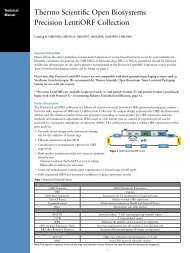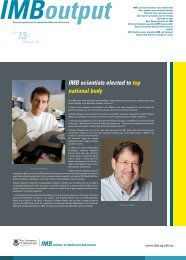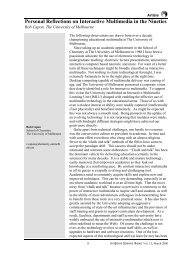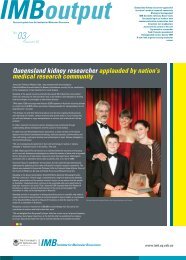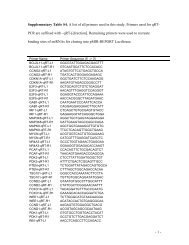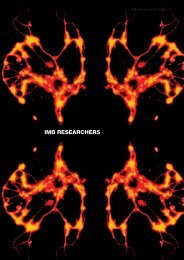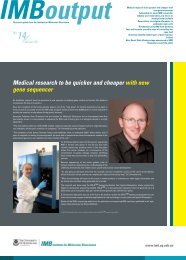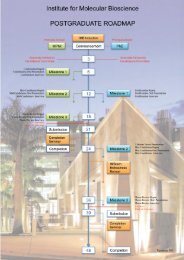2010 Annual Report - Institute for Molecular Bioscience - University ...
2010 Annual Report - Institute for Molecular Bioscience - University ...
2010 Annual Report - Institute for Molecular Bioscience - University ...
Create successful ePaper yourself
Turn your PDF publications into a flip-book with our unique Google optimized e-Paper software.
imb annual report <strong>2010</strong><br />
38<br />
BRANDON WAINWRIGHT<br />
TISSUE REPAIR AND CANCER<br />
USING GENOMIC APPROACHES,<br />
our group mapped and isolated the gene<br />
<strong>for</strong> the heritable cancer disorder, naevoid<br />
basal cell carcinoma syndrome (NBCCS).<br />
The patched gene, discovered from our<br />
studies on NBCCS, has defined a signalling<br />
pathway known as the “hedgehog<br />
pathway”, which appears to be mutated<br />
or perturbed in a wide range of tumour<br />
types, including lung, gastro-intestinal, skin,<br />
pancreatic, prostate, brain and ovarian<br />
cancer. This has led us to focus on the<br />
role of hedgehog signalling, not only in<br />
cancer but also on the regulation of stem<br />
cell compartments. Increasingly it appears<br />
that in some tumour types there are cells<br />
known as “cancer stem cells” which reside<br />
within the tumour and are responsible <strong>for</strong><br />
the overall phenotype. Currently such cells<br />
can be partially defined functionally but<br />
their molecular signature remains elusive.<br />
We believe that the patched/hedgehog<br />
pathway defines many of the characteristics<br />
of such stem cells and is a powerful starting<br />
point <strong>for</strong> understanding tumour biology and<br />
the development of new therapeutics.<br />
Given that cancer represents a state of<br />
unregulated cell growth, it is likely that<br />
the pathways that lead to cancer are<br />
also involved in the normal process of<br />
tissue growth and repair. Several of our<br />
studies are particularly directed at the role<br />
of the hedgehog (and other pathways)<br />
in repair and regeneration. The two<br />
most common cancer types in NBCCS<br />
patients are basal cell carcinoma of the<br />
Above and below: Loss of patched leads<br />
directly to skin tumours.<br />
skin and medulloblastoma, a common<br />
brain tumour occurring predominantly in<br />
children. In the example of both tumour<br />
types we are examining how activation<br />
of the hedgehog pathway causes the<br />
tumour, and defining the cell of origin of the<br />
tumour using a combination of molecular<br />
genetics and cell biology. We are also<br />
defining the interaction of the hedgehog<br />
pathway with other genetic pathways,<br />
such as Notch signalling, in order to<br />
understand the normal development of<br />
the skin and the cerebellum, but also what<br />
therapeutic strategies might be useful to<br />
treat the tumours. In addition to studying<br />
known pathways, we are seeking new<br />
interactions through genomic approaches<br />
to discovering new genes and pathways<br />
in model systems such as mice and<br />
zebrafish. The IMB has a well-developed<br />
drug discovery plat<strong>for</strong>m and we are<br />
using our knowledge of the biology of<br />
these tumours to look <strong>for</strong> potential new<br />
therapeutics.<br />
As part of our experimental approach<br />
our laboratory makes extensive use of<br />
transgenic and knockout mice. However<br />
at all points we refer back to the human<br />
diseases under study and have major<br />
activities based around mutation analysis,<br />
transcriptomics and proteomics of human<br />
material, integrating the data from all<br />
systems.<br />
As a result of these studies we have a<br />
particular interest in the interface between<br />
developmental cell biology and human<br />
genetics, and in therapeutic interventions<br />
such as gene or cell therapies.<br />
RESEARCH PROJECTS<br />
• Controlling neuronal stem cells and<br />
CNS by the patched/hedgehog<br />
pathway<br />
• Investigating the molecular basis of<br />
primary brain tumours<br />
• Controlling the stem cell niche in<br />
mammalian epidermis and skin cancer<br />
• Discovery of new genes capable of<br />
suppressing tumour growth<br />
• The role of microRNAs in brain tumour<br />
development<br />
KEY PUBLICATIONS<br />
The International Cancer Genome<br />
Consortium (Wainwright, B.J. listed<br />
as member of initial scientific planning<br />
committee) (<strong>2010</strong>). International network<br />
of cancer genome projects. Nature 464:<br />
993-998.<br />
Thomas, W.D., Chen, J., Gao, Y.R.,<br />
Cheung, B., Koach, J., Sekyere,<br />
E., Norris, M.D., Haber, M., Ellis, T.,<br />
Wainwright, B., and Marshall, G.M.<br />
(2009). Patched1 deletion increases<br />
N-Myc protein stability as a mechanism<br />
of medulloblastoma initiation and<br />
progression. Oncogene 28: 1605-1615.<br />
Yang, Z.J., Ellis, T., Markant, S.L., Read,<br />
T.A., Kessler, J.D., Bourboulas, M., Schüller,<br />
U., Machold, R., Fishell, G., Rowitch,<br />
D.H., Wainwright, B.J., and Wechsler-<br />
Reya, R.J. (2008). Medulloblastoma can<br />
be initiated by deletion of Patched in<br />
lineage-restricted progenitors or stem<br />
cells. Cancer Cell 14: 135-145.<br />
Adolphe, C., Hetherington, R., Ellis, T.,<br />
and Wainwright, B. (2006). Patched1<br />
functions as a gatekeeper by promoting<br />
cell cycle progression. Cancer Research<br />
66: 2081-2088.<br />
LAB MEMBERS<br />
Research Officers: Dr Richa Dave, Dr<br />
Rehan Villani, Dr Christelle Adolphe, Dr<br />
Jonathan Robson, Dr Elaine Julian<br />
Research Assistant: Melissa Bourboulas<br />
PhD Students: Uda Ho, Lena Constantin,<br />
Rhonda Kan, Peter Yee<br />
Undergraduate Students: Eriza<br />
Secondes, Paul Joosa, Stephanie Kamp,<br />
Chun Tatt Lim<br />
Visitors: Luis Milla




